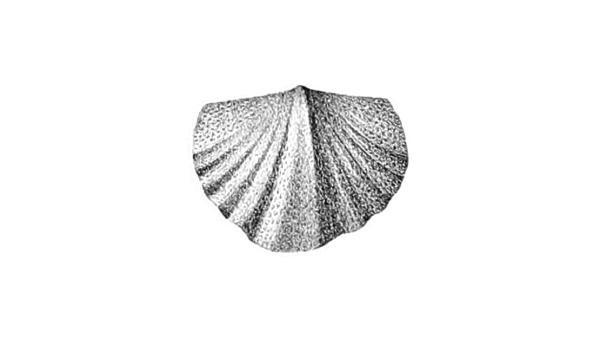Scientific Classification
| Kingdom: Animalia |
| Phylum: Brachiopoda |
| Class: Rynchonellata |
| Order: Spiriferida |
| Family: Echinospiriferidae |
| Genus: Pustulatia |
| Species: Pustulatia pustulosa (Hall, 1860) |
Information
Geological Range
Paleogeographic Distribution
Stratigraphic Occurrences
References
Hall (1867) (as Vitulina pustulosa): p. 410 pl. 62.
Linsley (1994): p. 200, figs 35-44.
Wilson (2014): pp. 112, 113.
Remarks
Originally described as Vitulina pustulosa by Hall in 1860. Recombined as Pustulina pustulosa by Cooper in 1942, due to the name Vitulina already being in use for a gastropod named by Swainson. Recombined as Pustulatia pustulosa by Cooper in 1956, due to the name Pustulina already being in use.
From Wilson (2014, p. 112): “Medium-sized, roughly semicircular shell. Rounded plications on both valves, with pustules giving a rough surface. To 20 mm.”
From Carlton Brett and Gordon Baird: “Pustulatia pustulosa originated outside of the Eastern American Realm. This brachiopod first appears in the Emsian in the cool water Malvinokafric Realm. This brachiopod apparently invaded, perhaps on multiple occasions, forming incursion epiboles of stratigraphic importance but did not become a common part of the EAR biofacies. The facies distribution of this brachiopod also does not follow a predictable pattern. Early examples in the upper Skaneateles and lower Ludlowville formations are as brief epiboles one in the dark shales of the eastern Butternut Member and in local pockets in the dark lower Ledyard Shale. They also occur more rarely in diverse brachiopod assemblage of the Centerfield member in some eastern localities. Their next higher occurrences are the Tichenor and Kashong members of the Moscow Formation, where they are moderately common in high diversity brachiopod assemblages. Finally, after considerable outage they return in the uppermost Moscow Garrattsville Member where Pustulatia beds form a widely mappable epibole in dark dysoxic facies. This Moscow Pustulatia beds are widely traceable in eastern New York and central Pennsylvania. Hence, like some other brachiopods, notably Tropidoleptus, Pustulatia appears in two disparate facies. Larger specimens can be a part of diverse brachiopod faunas especially the Kashong-like Tropidoleptus-Nucleospira biofacies, but also smaller specimens occur in large numbers in a few thin beds within dysoxic dark shale facies. Possibly this represents the repeated evolution of low oxygen tolerant ecomorphs, via paedomorphosis, which then behaved as explosive opportunists under certain environmental conditions. This pattern is mimicked but several diminutive brachiopods such as Truncalosia and Crurispina, which may co-occur with Pustulatia in its epiboles.”
Online Resources
Media
Images


